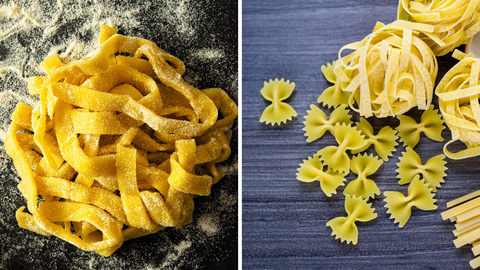When it comes to Italian cuisine, pasta reigns supreme. But within this beloved realm, a debate simmers: fresh versus dried pasta. Both offer delicious possibilities, but understanding their distinctions can elevate your pasta game.
Ingredients and Processing
The core difference lies in the processing methods and ingredients used.
Fresh pasta is crafted with soft wheat flour or durum wheat semolina, water, and eggs (typically just yolks). The dough is then rolled out by hand or with specialized machines before being cut into various shapes.
Dried pasta, on the other hand, has a simpler composition: solely durum wheat semolina and water. The dough is extruded through dies with different shapes and then dried.
Storage Life
Another crucial aspect is shelf life.
Fresh pasta is a living product and has a short expiration window, lasting only a few days. It needs to be consumed within 2-3 days of preparation to fully appreciate its flavor and texture.
Conversely, dried pasta, thanks to the drying process, boasts a significantly longer lifespan, potentially lasting several months or even years.
Cooking and Flavor
Cooking times also differ.
Fresh pasta cooks in mere minutes, 2-3 for smaller shapes and 5-6 for larger ones.
Dried pasta necessitates longer cooking times, varying based on shape and thickness, ranging from 8 to 12 minutes.
In terms of taste, fresh pasta boasts a richer and more intense flavor profile due to its higher water content and the inclusion of eggs.
Dried pasta offers a more delicate and neutral flavor, perfectly suited to being accentuated by elaborate sauces and condiments.
Calories and Nutritional Value
Fresh pasta, being richer in water content, has a lower calorie count compared to dried pasta. Roughly 270 kcal per 100 grams versus 370 kcal for dried pasta. However, during cooking, fresh pasta absorbs more water, increasing its calorie content.
Fresh or Dried? The Choice is Yours
There’s no clear winner here.
Fresh pasta and dried pasta are two distinct products, each offering unique advantages. Fresh pasta delivers a luxurious, quick-cooking experience, while dried pasta provides convenience, versatility, and a longer shelf life. Ultimately, the best choice depends on your recipe and preferences.
So, the next time you reach for pasta, consider the dish you're creating and explore the exciting possibilities of both fresh and dried varieties.
After all, in the world of Italian cuisine, variety is truly the spice of life.



